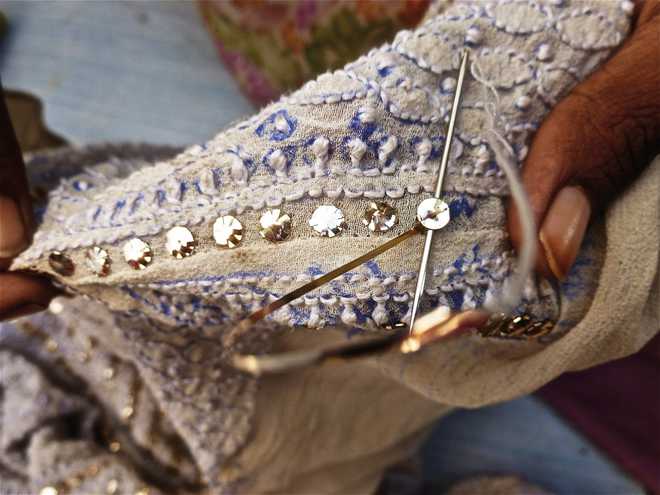Paola Manfredi
Chikankari is reputed to be among the finest traditional embroideries from India, typical of Lucknow, once the capital of the vast and rich dominions of the state of Awadh. With the gradual decline of Mughal authority in the second half of the 18th century, the Nawabs of Awadh established their independence from the Delhi court. They gave credence to the legendary extravagances of oriental monarchies, shaping their own aesthetic and style, and redefining the concept of court splendour and royal patronage. From the late 18th and up to the middle of the 19th century, Lucknow attracted artists, artisans, musicians, chefs and literary figures, all seeking royal favour. This influx contributed to Lucknow’s glowing reputation for beautiful Urdu poetry and literature, for classical music and dance, for fairs and grand Muharram processions. Lucknawi lifestyle came to define class, taste, manners and culture.
A variety of arts and crafts, in particular embroideries of several kinds, flourished in this atmosphere of wealth and sophistication. The karkhanas, or royal workshops, produced exquisite works of zardozi, ari and kamdani embroideries with gold and silver threads on silks, velvets and fine muslins. Chikan embroidery, although it developed towards the end of the Nawabi era, is often taken to epitomize the best and ultimate refinement of Nawabi and Lucknawi culture. ‘Classical’ chikankari is intricate, yet delicate, white embroidery on very fine white muslin, wherein different stitches create myriads of subtle combinations and textures.
In spite of its celebrated, almost iconic status in Lucknow, chikan embroidery has hardly ever been the focus of in depth research or descriptive works.
Towards the end of 19th century chikan embroidery appears to have been a thriving business, as “rumals, doputtahs, bels (for insertion), chadars” were “in great demand in all parts of India” and they were “largely exported from Lucknow to Agra in the N-W, Mirzapur, Patna, and Calcutta in the East, Haiderabad and Dakhan.”
By the turn of the century, chikan embroidery in Lucknow had further grown in popularity. Sir George Watt, the Director of the Indian Art Exhibition in Delhi in 1903, wrote that “The Kings of Oudh attracted to their capital many of the famous craftsmen of India, hence Lucknow, to this day, has a larger range of artistic workers than are to be found in almost any other town of India. Lucknow chikan work is perhaps the most remarkable of these crafts as it is the most artistic and most delicate form of what might be called the purely indigenous needlework of India.”
In the middle of the 1980s, an organization called Self Employed Women Association (SEWA) Lucknow, brought about dramatic changes in the chikan industry, both in the life of artisans and in the quality of chikan that became available.
Not all of SEWA-Lucknow’s productions are of the highest workmanship as they have to accommodate their growing members belonging to different skill levels.... The early exhibitions in Delhi and Mumbai caused a sensation with their range of beautifully embroidered and stylish pieces. All this plus a celebrated pioneering collection of chikan embroidery on diaphanous silk organza designed by Ritu Kumar and executed by SEWA’s craftswomen played a major role in placing chikan at the centre stage of the then emerging high fashion industry in India.
The challenge to firmly position chikan embroidery as couture apparel was taken up in the late 1980s by young designers Abu Jani and Sandeep Khosla. Their richly embroidered chikan kurtas and saris created a sumptuous, enduring white-on-white look. Their impeccably executed designs reflect the great skills of this tradition, even though antique chikankari craft was associated more to understatement than to opulence. Since then, high fashion chikankari has been endorsed by Bollywood stars and social celebrities, associated with the erstwhile splendour of Indian courts, and promoted by the descendants of local aristocracy like the princely families of Kotwara and Mahmudabad — all of which has contributed to the revival of fine workmanship and sophisticated artistry.
Over the last twenty years or so, many other designers have been working with this craft, far too many to be listed here. Most of them are developing designs within traditional patterns or more precisely within what it is perceived to be traditional. Rajesh Pratap Singh has been experimenting with chikan embroidery for many years, applying it to most unconventional designs and motifs and often taking this craft to its cutting edges limits.
On the wave of such successes, a huge market for chikan has developed catering to all means and tastes, both in India and abroad. This market has high, medium or low budget, and crude mass-produced chikan, often copying the styles and designs of most popular trend setter designers’ brands. In fact, Lucknow has become a major hub for all sort of hand embroidery productions that are indistinctly grouped under ‘chikan embroidery’ label.
The number of chikan embroiderers was estimated to be around 40,000 in Lucknow and neighbouring districts in the mid-1980s. They are now assessed at over 2,50,000 thousand, most of them home-based workers. The entire cycle of hand-embroidered production is now estimated to sustain over a million people.
— Excerpted with permission from Chikankari: A Lucknawi Tradition by Paola Manfredi. Niyogi Books
Unlock Exclusive Insights with The Tribune Premium
Take your experience further with Premium access.
Thought-provoking Opinions, Expert Analysis, In-depth Insights and other Member Only Benefits
Already a Member? Sign In Now










